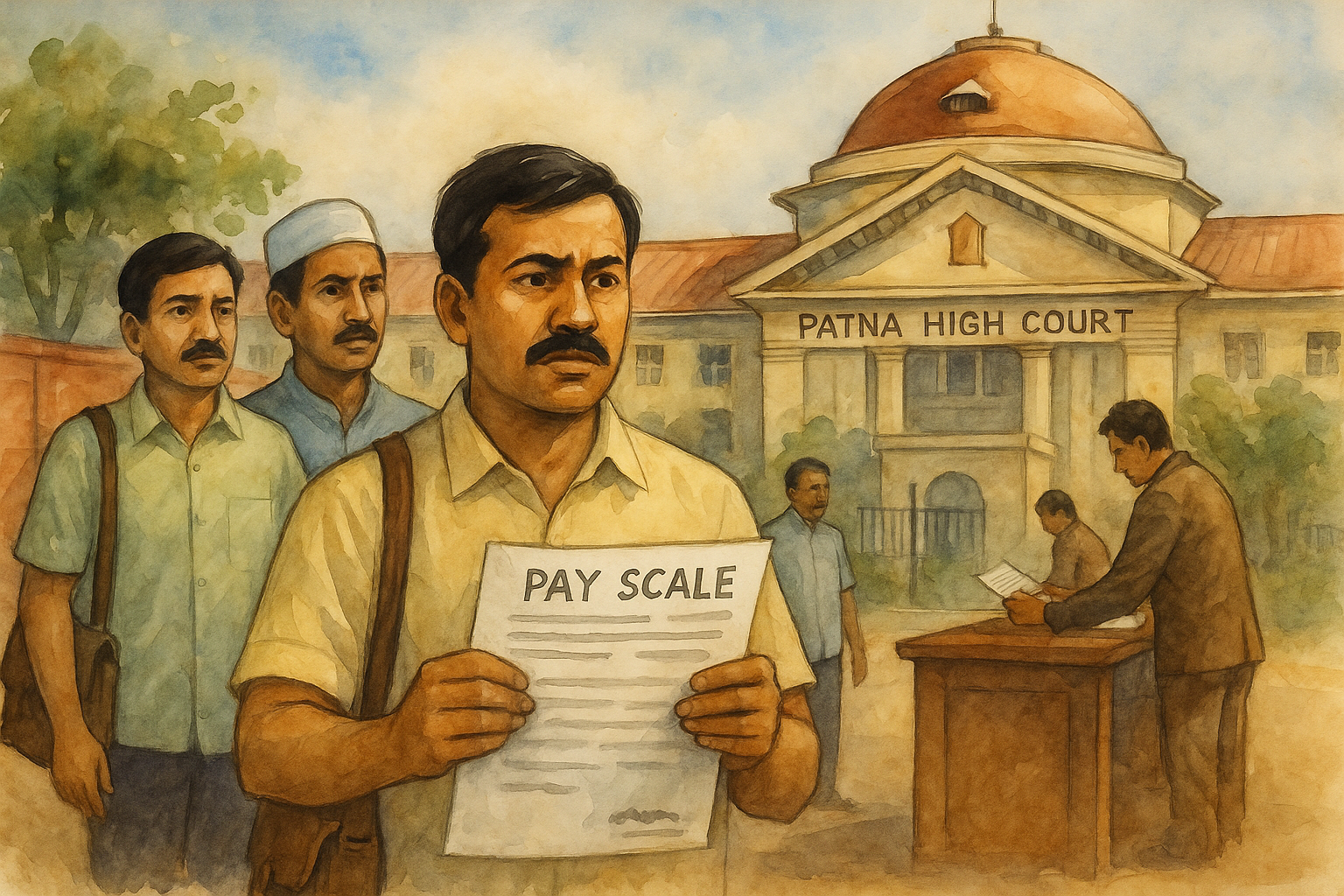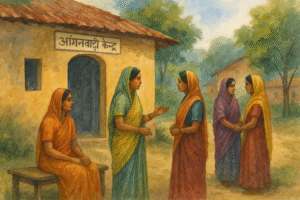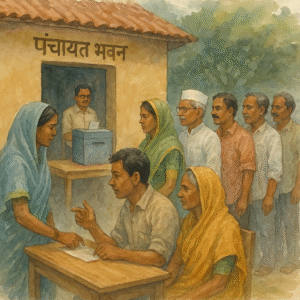The Patna High Court has directed that the petitioners—clerical staff working in recognized schools—be extended the revised pay scale of ₹4,000–6,000 (and its equivalent grade pay) in terms of an earlier Division Bench ruling, with a protective caveat that the benefit will abide by the result of a pending civil review before a Larger Bench. The Court disposed of the writ petitions in line with the Division Bench judgment in L.P.A. No. 167 of 2016 and required each beneficiary to give an undertaking to refund the amounts if the State ultimately succeeds.
The case arose from complaints that clerks in aided/recognized schools were wrongly continued in a lower pay band of ₹3,050–4,500, despite being similarly situated to others who had already been granted the higher pay band of ₹4,000–6,000 pursuant to prior High Court directions. The petition sought quashing of a departmental memo that had maintained the lower scale and asked for arrears and current salary fixation in the higher scale from the date of joining, relying on earlier High Court and LPA decisions.
On hearing both sides, the Court noted that (a) multiple Benches had extended similar relief earlier based on the Division Bench judgment in L.P.A. No. 167 of 2016; (b) a civil review against that LPA is pending before a Larger Bench; and (c) the State’s General Administration Department and Finance Department had already issued letters indicating compliance with the LPA judgment, subject to the outcome of Civil Review No. 236 of 2019. The Court also recorded an instance where the District Magistrate, Kaimur (Bhabhua) implemented the higher scale on 08.11.2023 on the same “subject to review” basis.
Crucially, the Court invoked the Bihar State Litigation Policy, 2011 (Clause 4.C(1)), which urges departments to settle “similar cases” administratively when the claim is already covered by a court decision rather than compelling citizens to litigate. This policy orientation supported extending parity-based relief without waiting indefinitely for the review, while still protecting the exchequer through the standard undertaking requirement.
Simplified Explanation of the Judgment
This judgment addresses a recurring service-law dispute: whether clerical staff in recognized schools are entitled to a higher, parity-based pay scale of ₹4,000–6,000 (with corresponding grade pay), instead of the lower pay band of ₹3,050–4,500. The petitioners contended that similarly situated employees had already received the higher scale, and that a Division Bench of the Patna High Court (L.P.A. No. 167 of 2016) had effectively settled the issue in favor of employees like them. They therefore asked the Court to set aside a departmental memo that kept them on the lower scale and to order arrears and current payments in the higher scale from the date of joining.
The State did not dispute that some reliefs had been granted in past proceedings. However, the State submitted that there are two Division Bench judgments pulling in different directions—L.P.A. No. 167 of 2016 (favorable to employees) and L.P.A. No. 100 of 2012 (favorable to the State). Owing to the conflicting positions, a reference was made, the State also filed Civil Review No. 236 of 2019 against the favorable LPA, and the entire issue is now pending before a Larger Bench. The State requested that similar matters should await the outcome of that review to avoid inconsistent or premature relief.
The Court took a balanced approach. It recognized (1) the existence of a settled line of Single Bench orders granting the higher scale to similarly placed persons based on L.P.A. No. 167 of 2016; (2) the State’s own administrative stance—evidenced by letters issued by the General Administration Department and the Finance Department in early 2023—to comply with the LPA judgment, albeit conditionally, pending the review; and (3) a recent district-level order (08.11.2023) implementing the higher scale in the same “subject to review” manner. These facts demonstrated a factual reality: many similarly situated employees are already getting the higher pay scale under a protective umbrella, and departments are operationally prepared to comply in like cases while the review is pending.
The Court then brought in Clause 4.C(1) of the Bihar State Litigation Policy, 2011. This clause encourages government departments to resolve “similar cases” administratively when the claim is already covered by a court decision, thus minimizing unnecessary litigation. The policy’s logic is simple and citizen-centric: if the issue is materially covered by an existing ruling, a department should extend the same benefit rather than forcing each individual to file a writ. Relying on this policy and the body of past orders, the Court held that the present petitions could be disposed of by granting the same relief that had been provided earlier under L.P.A. No. 167 of 2016.
At the same time, the Court protected the State’s position in the pending Larger Bench review. It did this by making two key safeguards explicit:
- The relief is expressly “subject to the final outcome” of Civil Review No. 236 of 2019 pending before the Larger Bench. If the Larger Bench eventually rules in favor of the State, the authorities would be entitled to revert or modify the benefit in line with that final ruling.
- Each beneficiary must file an undertaking before the concerned authority agreeing to refund any amount received if the Larger Bench and/or the civil review goes in favor of the State Government. This ensures that interim disbursal does not permanently prejudice public finances and allows parity-based relief to operate responsibly in the interim.
In effect, the Court’s order harmonizes two competing considerations: (a) the need for parity and consistency for similarly placed employees during the pendency of a review; and (b) the need to protect the public exchequer pending a final authoritative pronouncement. The decision streamlines outcomes by relying on existing judicial and administrative precedent while staying firmly within the boundaries set by the pending review.
For employees, this means that if they are similarly situated to those covered by L.P.A. No. 167 of 2016, they should receive the higher scale (₹4,000–6,000 or equivalent in the revised pay structure) now, with arrears and current salary fixation, provided they furnish the required undertaking. For departments, the order reinforces the State Litigation Policy’s mandate to resolve similar claims without pushing litigants into court, while keeping a safety net through the “subject to review” condition and refund undertaking.
Significance or Implication of the Judgment (For general public or government)
- For employees: It clarifies that similarly placed clerical staff in recognized schools can get parity-based pay fixation in the higher scale now—subject to the final outcome of the pending review—if they file an undertaking to refund if required. This can reduce avoidable litigation and accelerate relief in comparable cases.
- For government: The judgment operationalizes the Bihar State Litigation Policy, 2011, by encouraging departments to extend benefits in “similar cases” based on existing decisions rather than compelling each employee to litigate. That promotes administrative efficiency and legal consistency while safeguarding public funds through undertakings.
Legal Issue(s) Decided and the Court’s Decision with reasoning
- Issue: Whether clerical staff in recognized schools, situated similarly to beneficiaries of L.P.A. No. 167 of 2016, are entitled to the higher pay scale of ₹4,000–6,000 (or equivalent).
Decision: Yes—writ petitions disposed of by granting relief “exactly in terms of” L.P.A. No. 167 of 2016. - Issue: How to balance parity-based relief with a pending civil review before a Larger Bench.
Decision: Relief is granted subject to the final outcome of Civil Review No. 236 of 2019; beneficiaries must furnish an undertaking to refund amounts if the State succeeds. - Issue: Applicability of the Bihar State Litigation Policy, 2011, to “similar cases.”
Decision: The Court invoked Clause 4.C(1) to justify extending similar relief without forcing repetitive litigation.
Judgments Referred by Parties
- Petitioners: Relied on L.P.A. No. 167 of 2016; cited consistent Single Bench reliefs and an order in C.W.J.C. No. 188 of 2021 dated 09.07.2021.
- State: Pointed to conflicting Division Bench outcomes—L.P.A. No. 167 of 2016 (employee-friendly) and L.P.A. No. 100 of 2012 (State-friendly)—and highlighted the pendency of Civil Review No. 236 of 2019 before a Larger Bench.
Judgments Relied Upon or Cited by Court
- The Court followed L.P.A. No. 167 of 2016 and disposed of the writ petitions “exactly in terms of” that Division Bench ruling, while making the relief subject to Civil Review No. 236 of 2019. It also invoked Bihar State Litigation Policy, 2011 (Clause 4.C(1)).
Case Title
Kaushal Kishor Singh & Ors. v. State of Bihar & Ors.
Case Number
Civil Writ Jurisdiction Case No. 3819 of 2024 (disposed of on 15.05.2024)
Citation(s)
2025 (1) PLJR 588
Coram and Names of Judges
Hon’ble Mr. Justice Anjani Kumar Sharan (Oral Judgment dated 15.05.2024)
Names of Advocates and who they appeared for
- For the petitioners: Mr. Amaresh Kumar Singh
- For the State (respondents): Mr. Manoj Kumar Ambastha, SC-26; Mr. Divit Vinod, AC to SC-26
Link to Judgment
MTUjMzgxOSMyMDI0IzEjTg==-FtRkpmfQ5f0=
If you found this explanation helpful and wish to stay informed about how legal developments may affect your rights in Bihar, you may consider following Samvida Law Associates for more updates.








